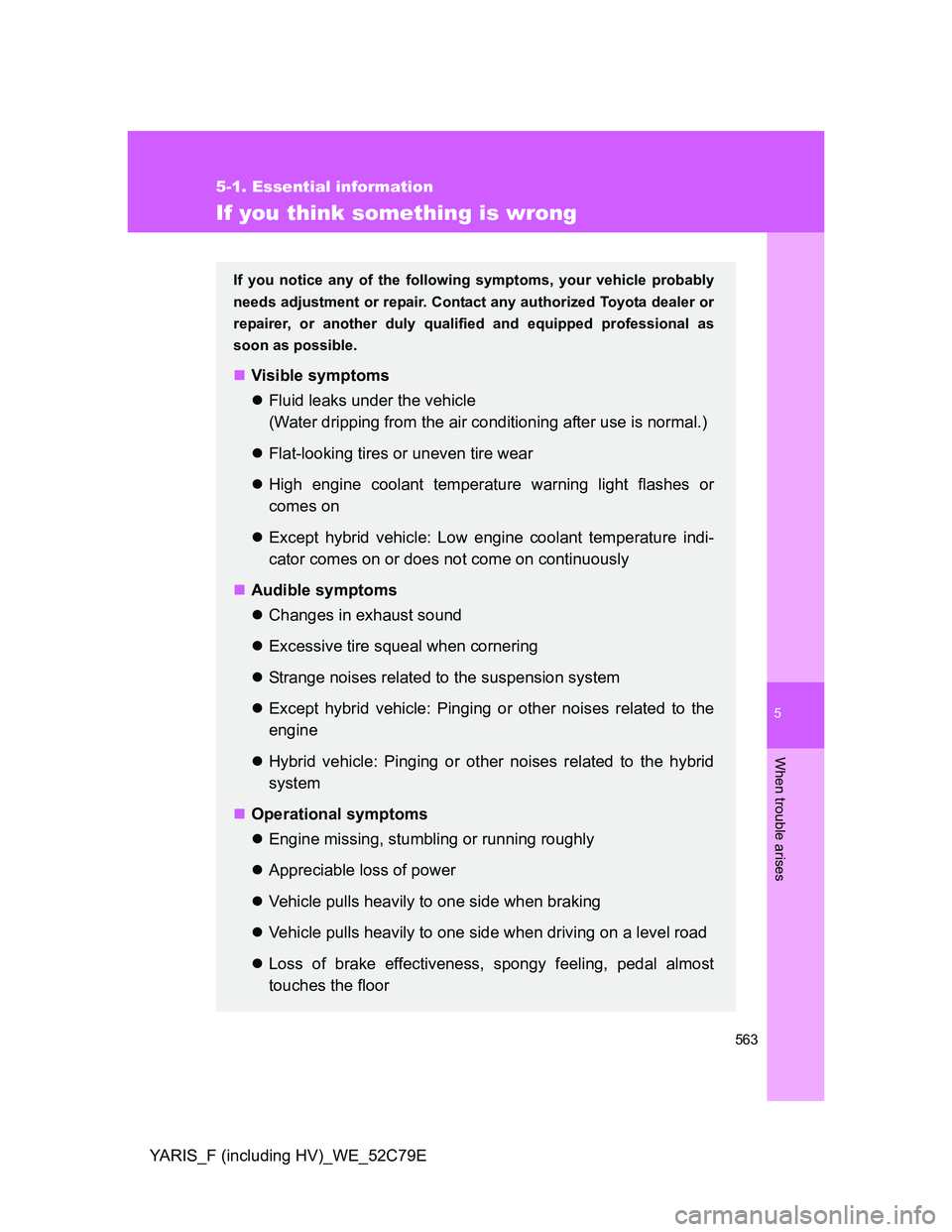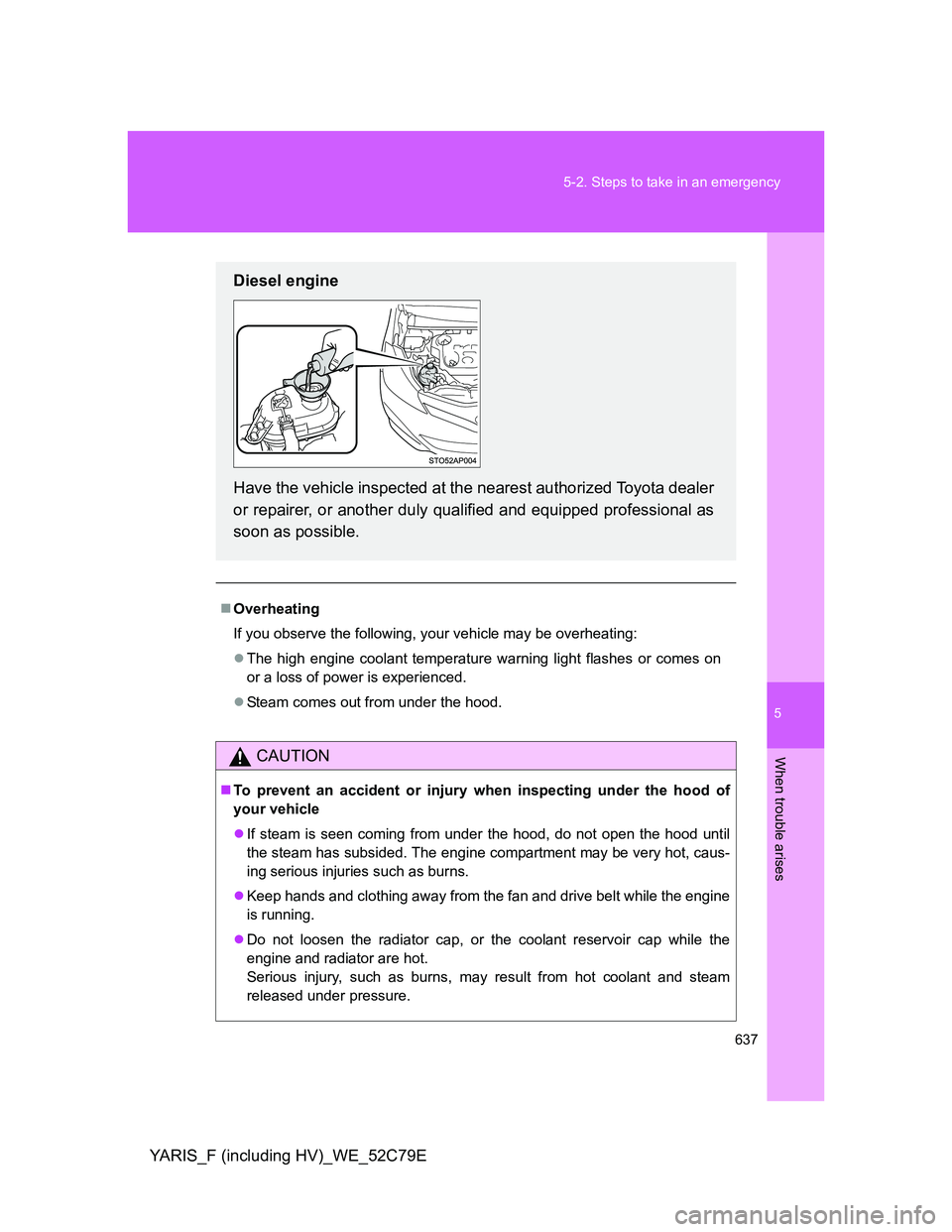Page 480 of 704

480 4-3. Do-it-yourself maintenance
YARIS_F (including HV)_WE_52C79E
Coolant selection
Only use “Toyota Super Long Life Coolant” or a similar high quality ethylene
glycol based non-silicate, non-amine, non-nitrite, and non-borate coolant
with long-life hybrid organic acid technology.
“Toyota Super Long Life Coolant” is a mixture of 50% coolant and 50%
deionized water. (Minimum temperature: -35C [-31F])
For more details about engine coolant, contact any authorized Toyota dealer
or repairer, or another duly qualified and equipped professional.
If the coolant level drops within a short time of replenishing
Except hybrid vehicle: Visually check the radiator, hoses, engine coolant res-
ervoir cap, drain cock and water pump.
Hybrid vehicle: Visually check the radiator, hoses, engine/power control unit
coolant reservoir caps, drain cock and water pump.
If you cannot find a leak, have any authorized Toyota dealer or repairer, or
another duly qualified and equipped professional, test the cap and check for
leaks in the cooling system.
CAUTION
When the engine is hot (except hybrid vehicle)
Do not remove the radiator cap (gasoline engine), or the engine coolant res-
ervoir cap (diesel engine).
The cooling system may be under pressure and may spray hot coolant if the
cap is removed, causing serious injuries, such as burns.
When the hybrid system is hot (hybrid vehicle)
Do not remove the engine/power control unit coolant reservoir caps.
The cooling system may be under pressure and may spray hot coolant if the
cap is removed, causing serious injuries, such as burns.
Page 481 of 704

481 4-3. Do-it-yourself maintenance
4
Maintenance and care
YARIS_F (including HV)_WE_52C79E
Radiator, condenser and intercooler
Check the radiator, condenser and intercooler and clear away any
foreign objects.
If any of the above parts are extremely dirty or you are not sure of
their condition, have your vehicle inspected by any authorized Toyota
dealer or repairer, or another duly qualified and equipped profes-
sional.
NOTICE
When adding coolant
Coolant is neither plain water nor straight antifreeze. The correct mixture of
water and antifreeze must be used to provide proper lubrication, corrosion
protection and cooling. Be sure to read the antifreeze or coolant label.
If you spill coolant
Be sure to wash it off with water to prevent it from damaging parts or paint.
CAUTION
When the engine is hot (except hybrid vehicle)
Do not touch the radiator, condenser or intercooler as they may be hot and
cause serious injuries, such as burns.
When the hybrid system is hot (hybrid vehicle)
Do not touch the radiator or condenser as they may be hot and cause seri-
ous injuries, such as burns.
Page 563 of 704

5
563
5-1. Essential information
When trouble arises
YARIS_F (including HV)_WE_52C79E
If you think something is wrong
If you notice any of the following symptoms, your vehicle probably
needs adjustment or repair. Contact any authorized Toyota dealer or
repairer, or another duly qualified and equipped professional as
soon as possible.
Visible symptoms
Fluid leaks under the vehicle
(Water dripping from the air conditioning after use is normal.)
Flat-looking tires or uneven tire wear
High engine coolant temperature warning light flashes or
comes on
Except hybrid vehicle: Low engine coolant temperature indi-
cator comes on or does not come on continuously
Audible symptoms
Changes in exhaust sound
Excessive tire squeal when cornering
Strange noises related to the suspension system
Except hybrid vehicle: Pinging or other noises related to the
engine
Hybrid vehicle: Pinging or other noises related to the hybrid
system
Operational symptoms
Engine missing, stumbling or running roughly
Appreciable loss of power
Vehicle pulls heavily to one side when braking
Vehicle pulls heavily to one side when driving on a level road
Loss of brake effectiveness, spongy feeling, pedal almost
touches the floor
Page 566 of 704
566 5-2. Steps to take in an emergency
YARIS_F (including HV)_WE_52C79E
Stop the vehicle immediately.
The following warnings indicate the possibility of damage to the
vehicle that may lead to an accident. Immediately stop the vehicle
in a safe place and contact any authorized Toyota dealer or
repairer, or another duly qualified and equipped professional.
Warning lightWarning light/Details
Charging system warning light
Indicates a malfunction in the vehicle’s charging system.
Low engine oil pressure warning light
Indicates that the engine oil pressure is too low.
(Flashes or
comes on)High engine coolant temperature warning light
Indicates that the engine is overheating. (P. 635, 639)
• Flashes: Engine is overheating. Drive carefully.
• Comes on: Engine is overheated. Stop the vehicle.
Hybrid system warning light and warning buzzer
(hybrid vehicle)
Indicates a malfunction in the hybrid system.
Page 635 of 704
5
635
5-2. Steps to take in an emergency
When trouble arises
YARIS_F (including HV)_WE_52C79E
If your vehicle overheats (except hybrid vehicle)
If your engine overheats:
Stop the vehicle in a safe place and turn off the air condi-
tioning system.
Check to see if steam is coming out from under the hood.
If you see steam:
Stop the engine. Carefully lift the hood after the steam sub-
sides and then restart the engine.
If you do not see steam:
Leave the engine running and carefully lift the hood.
Check to see if the cooling fan is operating.
If the fan is operating:
Wait until the high engine coolant temperature warning light
goes off and then stop the engine.
If the fan is not operating:
Stop the engine immediately and call any authorized Toyota
dealer or repairer, or another duly qualified and equipped
professional.
After the engine has cooled down sufficiently, check the
engine coolant level and inspect the radiator core (radiator)
for any leaks.
Gasoline engine
Page 636 of 704
636 5-2. Steps to take in an emergency
YARIS_F (including HV)_WE_52C79E
Diesel engine
Add engine coolant if necessary.
Water can be used in an emergency if engine coolant is unavail-
able.
(P. 667)
Gasoline engine
Page 637 of 704

5
637 5-2. Steps to take in an emergency
When trouble arises
YARIS_F (including HV)_WE_52C79E
Overheating
If you observe the following, your vehicle may be overheating:
The high engine coolant temperature warning light flashes or comes on
or a loss of power is experienced.
Steam comes out from under the hood.
CAUTION
To prevent an accident or injury when inspecting under the hood of
your vehicle
If steam is seen coming from under the hood, do not open the hood until
the steam has subsided. The engine compartment may be very hot, caus-
ing serious injuries such as burns.
Keep hands and clothing away from the fan and drive belt while the engine
is running.
Do not loosen the radiator cap, or the coolant reservoir cap while the
engine and radiator are hot.
Serious injury, such as burns, may result from hot coolant and steam
released under pressure.
Diesel engine
Have the vehicle inspected at the nearest authorized Toyota dealer
or repairer, or another duly qualified and equipped professional as
soon as possible.
Page 638 of 704
638 5-2. Steps to take in an emergency
YARIS_F (including HV)_WE_52C79E
NOTICE
When adding engine coolant
Wait until the engine has cooled down before adding engine coolant.
When adding coolant, do so slowly. Adding cool coolant to a hot engine too
quickly can cause damage to the engine.